When raising livestock you are always on the lookout for ways to save on feed costs as it is the number one expense. Spring and summer months bring a natural reprieve with pasture for grazing, food scraps from the garden, and excess milk/ cheese making by products. But what about the winter? There’s no pasture, no garden, and certainly no milk to be spared. This is where sprouting grains for fodder can come into play.
Fodder, quite literally means food for animals. So, there are many different types of fodder. Hay, grain, pasture, silage, these are all “fodder”. So, for the purposes of this blog post, when I say fodder, I am referring to sprouted grains.
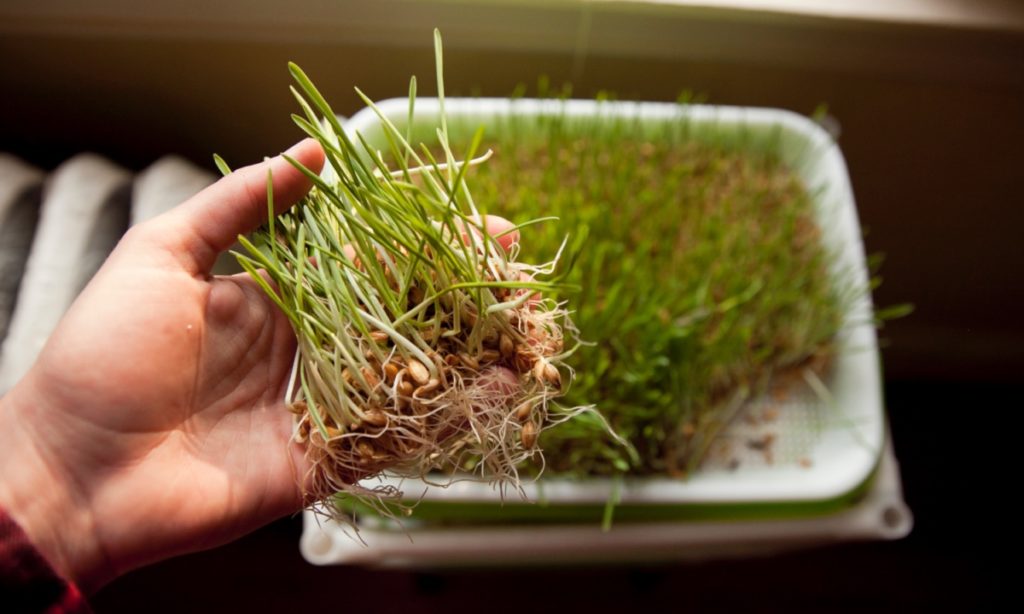
By taking your grain ( you can use a number of different types of grain it’s just a matter of figuring out what works best for you. I use barley because it’s highest in nutritional value and it’s readily available) soaking it in water for a day, and then spraying it daily for a week you can turn it into a lush blanket of grass with a thick root mat. Everything is edible! Not only that, but you triple the weight of the amount you are feeding out your livestock. So, a 50 pound bag of organic barley that runs $25, actually turns into 150 pounds of fodder. So rather than paying $.50 a pound, you are in fact paying $.16 a pound. Pretty awesome huh?
Just in case the cost savings wasn’t enough to get you interested there are some pretty amazing health benefits to supplementing your livestock’s feed ration with fodder:
- Increased nutritional value (vitamins, minerals, proteins, enzymatic activity, omega 3’s, amino acids, natural hormones, immune response) versus feeding grain form – great for fattening lambs and flushing ewes
- More easily digestible
- Increased hydration
- Increased milk production and butterfat content in dairy animals
- Healthier coat and hooves
- Lower pH in rumen
- Easier transition in spring to pasture full time
- Natural and fresh fee
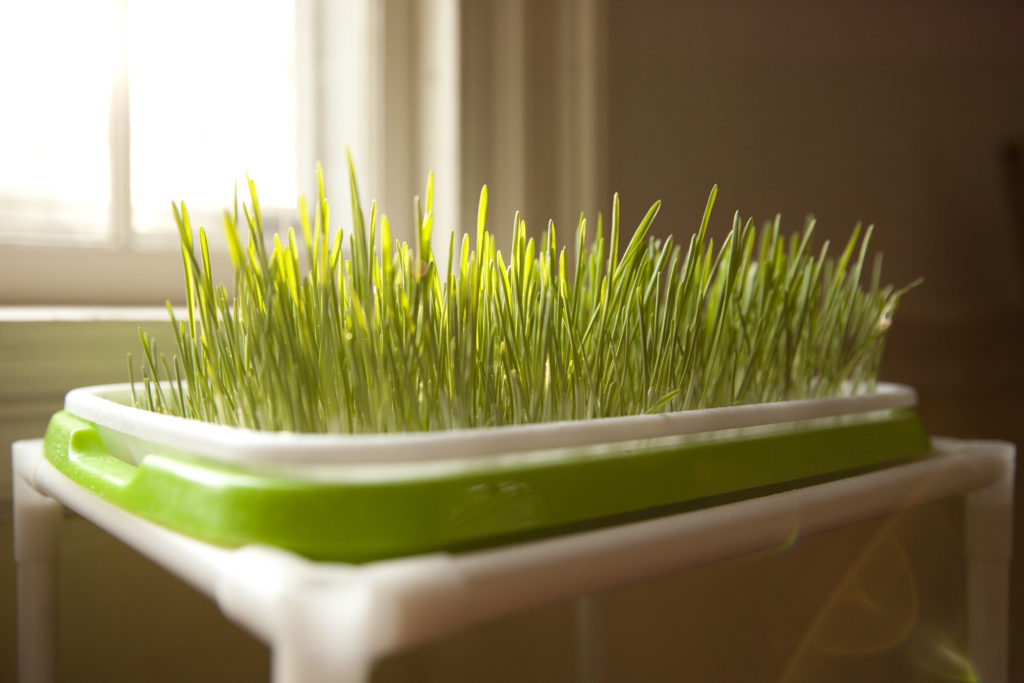
You Can Have too Much of a Good Thing
So you may be thinking ” oh wow this is amazing I’ll never have to buy hay again!”. Wrong. Sadly, this is not how it works. Fodder is a supplement and is part of a well balanced diet, and is not intended to be a substitute for hay as part of a complete diet.
But why? Because fodder is hydroponically grown and sprouted, the nutritional content is exponentially greater. For example, barley as a seed has a crude protein percentage of 12.7%. When sprouted, the crude protein spikes to almost 17%! Not only is it more nutrient dense, but it’s more digestible maximizing its absorption. So, they don’t need as much, as they are efficiently converting it to energy.
A percentage of the animals body weight determines how much fodder they should be fed out daily in addition to their normal feed ration (percentages below from Tractor Supply):
- Horse: 2-3 percent of their body weight in fodder; 1.5% body weight in dry hay
- Beef Cow: 2-3 percent of their body weight in fodder; barley straw ration
- Dairy Cow: 3-5 percent of their body weight in fodder; barley straw ration
- Sheep: 2-3 percent of their body weight in fodder; hay ration
- Goat: 2-3 percent of their body weight in fodder; mineral and hay rations
- Dairy Goat: 3-5 percent of their body weight in fodder; mineral and hay rations
- Alpaca: 2-3 percent of their body weight in fodder; hay ration
- Pig: 2-3 percent of their body weight in fodder
- Rabbit: 3-5 percent of their body weight in fodder; hay ration for roughage
- Chicken: 2-3 percent of their body weight in fodder; grit and calcium supplements
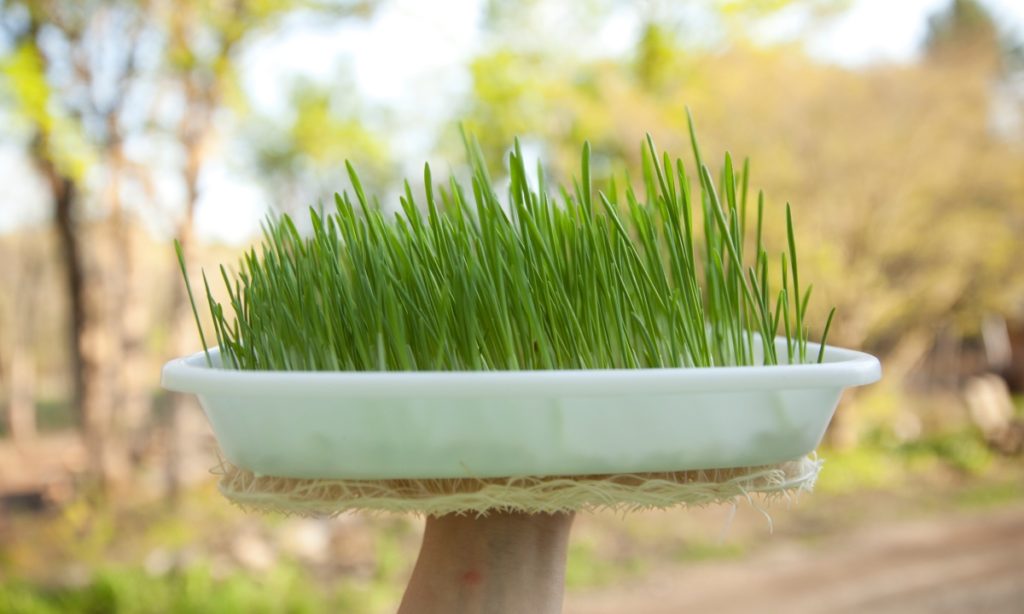
How To Sprout It
Sprouting fodder at home is incredibly easy and can be scaled up or down as much as you want. I am not going to get into the nitty gritty on how to make your shelving set up and your tray system. There are quite literally hundreds of different set ups you can find with a simple google search, and it will be all about finding what system works best for you. I currently am using a shelving system I got from Amazon because I didn’t have an old plastic shelf kicking around I could use, and I wanted something I could wheel around that didn’t look totally awful. I know I may need to scale up from this to meet my needs, but it’s giving me a start.
- Soak your grains in cool water for 12-24 hours. Drain and spread out onto a tray with drain holes with a tray below to catch water draining.
- Spray your grains twice daily with water so that they do not dry out. You don’t want them sitting in standing water (that’s why there are drain holes) but you want them to be consistently wet. Keeping your trays in a room with an ambient temperature of 60˚F-70˚F is ideal to promote sprouting and reduce mold growth. (**If you end up getting mold growth be sure to sanitize the pans before sprouting again)
- After just a day or two you will see the grains begin to sprout, and a couple days after that the grasses will begin to grow!! The grains will sprout and grow without sunlight, but sunlight is needed to turn the fodder green. Keeping your system near a window or in a well lit room is enough sunlight to get the job done. You don’t need grow lights or anything special unless you’re growing in a windowless room.
- Within 7 days or so you will have a lush blanket of grass that is ready to feed out to your livestock, root mat and all! You will want to feed it out fresh at this point, as the nutritional content is at its peak and it will not be able to develop any further hydroponically without fertilizer.
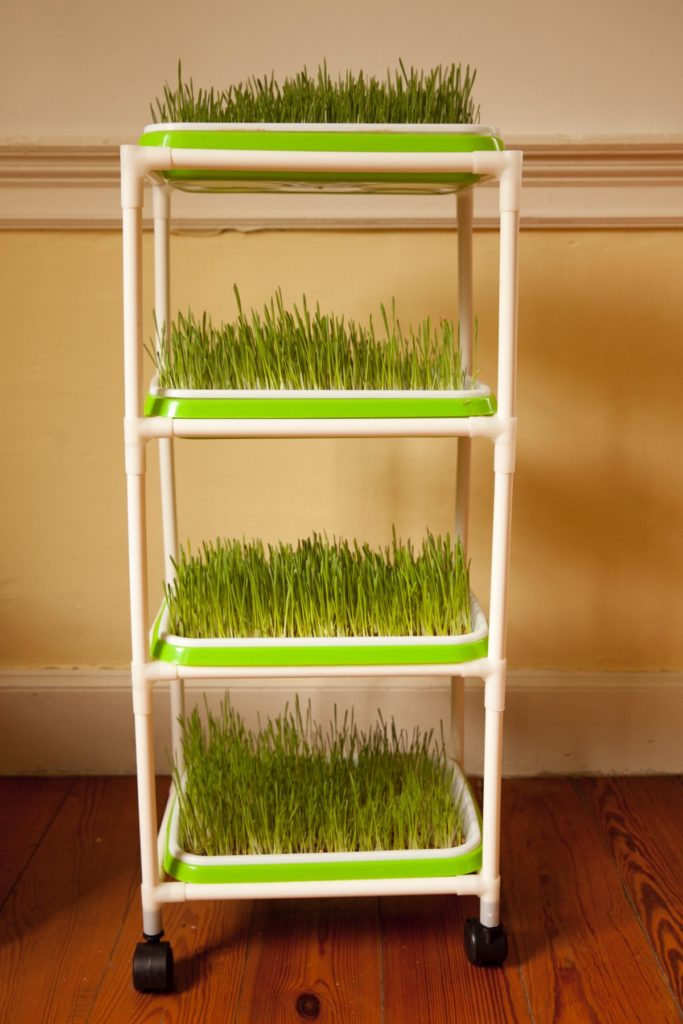
How I Plan To Use Fodder
Right now it’s spring and I currently have more than enough grass for everyone to forge for on their own. So I am taking advantage of this time and am working on getting a good rhythm in place figuring out a daily routine for sprouting grains for fodder. Although it takes merely minutes, I still am figuring it out. What room I want to keep my shelf in, how to spray my grains (sink or spray bottle), do I want to get another shelf from Amazon or come up with my own system, etc. I am figuring out this rhythm now so that over the coming months I can adjust my set up and be ready to go for the winter.
I will not be feeding this out to all of our animals. It’s simply just not doable! My three dairy goats alone would consume 12 pounds of fodder a day if I fed them their maximum daily ration. That doesn’t include the male goats, the sheep, or any of the pigs! Unless I wanted to dedicate an entire room to this, it’s just not feasible. But, that’s okay! Some is better than none, and even if I can’t feed out everyone their maximum ration, I can still feed out a portion of it and it will still provide amazing health benefits as well as help cut some costs.
The sheep will be gone by the end of fall as will the pigs, which leaves the dairy goats that will still be in milk. So, they are my priority, and my goal is to be able to provide each doe with at least two pounds of fodder a day to help stimulate milk production among other health benefits.
While I am just getting my “system” in place and figuring out the specifics of my set up, the health benefits and cost savings of sprouting grains for fodder cannot be denied. Whether you have a small herd of dairy goats, some ewes, a couple of chickens, or a whole menagerie like me, you too can do this to save some money while providing a nutrient dense supplement in the lean winter months, flushing for breeding, or fattening lambs!
Happy Sprouting,

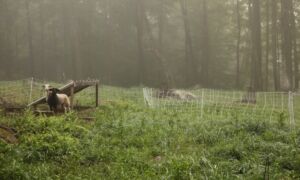

This is amazing! Thank you!
You’re very welcome!
Where did you get those trays?!? I love sprouting fodder for my animals but yet to find a tray that Im happy with…your set up is nice!
Got them from Amazon!!
We are growing fodder successfully. One ton per day using trays with each tray (12″ X 24″) planting 2 pounds of grain and producing 15 pounds in 6 days. After buying equipment from 3 suppliers, none worked, we invented our own.
Oran
That’s quite the system!
How did you like your fodder after using it through the winter?
I like it. I don’t have the set up to produce enough to really make any kind of dent in their feed bill, but it is a nice boost and I think they enjoy getting a little bit of fresh greens!